Top 10 HRM Models Every HR Professional Must Consider in 2025
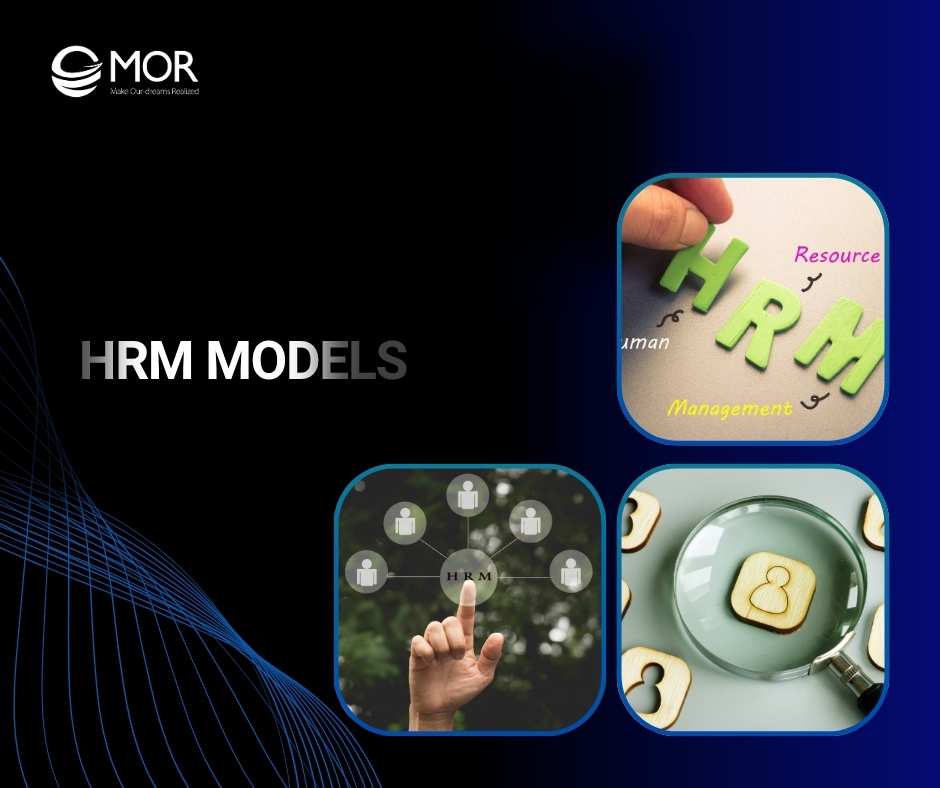
HR isn’t what it used to be. New ways of working, rising employee expectations, and shifting business goals demand more than just experience. They require structure. That’s where HRM models come in. They help HR teams work smarter, move faster, and deliver real value. In this guide, MOR Software breaks down 10 proven models to help HR teams lead with clarity and impact in 2025.
What Are HRM Models?
HRM models are structured approaches that help explain how human resources operate in a business. Think of them as the blueprint for how HR teams should organize their work, define responsibilities, and support company goals. They connect directly with your HR strategy by laying out the steps, actions, and priorities that bring that vision to life.
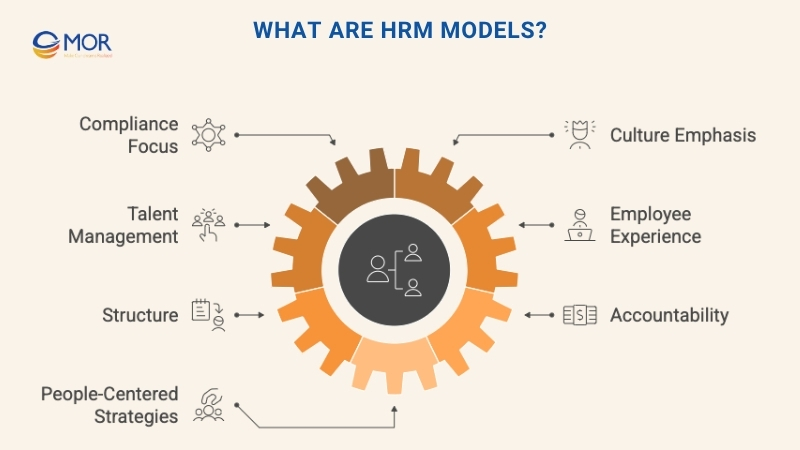
McKinsey estimates that about two‑thirds of routine HR tasks could be automated, allowing HR to redirect effort toward higher‑value work.
Most HR leaders rely on HRM models to clarify things like:
- What the core HR tasks and services should be. This is an important step because only 21% of people around the world feel engaged, and being clear can help increase that number.
- Who does what across recruiting, development, payroll, and performance
- How to measure outcomes and hold HR accountable
These models have shifted over time. HR used to focus mostly on policies and compliance. Now, it plays a bigger role in culture, talent strategy, and employee experience. The shift isn’t just about new titles. It’s about building a smarter, people-first approach to work.
And as this shift unfolds, different HRM management softwares have emerged. Each gives you a new lens to view the function of HR, whether you’re focusing on structure, accountability, or the human impact.
Key Benefits Of Using HRM Models
Using the right HRM models brings more than structure, it shapes how HR delivers value across the business.
- Provide structure and consistency in HR decision-making: Models give your team a clear framework to follow, which reduces guesswork and helps ensure policies and practices stay aligned, even as the company grows.
- Align HR practices with broader business goals: When HR knows where the business is headed, it can focus hiring, training, and performance efforts in the right direction. Models like the harvard model of HRM are especially useful for syncing people strategy with company vision.
- Improve talent acquisition, retention, and engagement: Disengaged workers cost the global economy $8.8 trillion in lost productivity. So clear systems help you attract better candidates, grow their skills, and keep them invested. Strategic models map out how to build and sustain a strong employee experience.
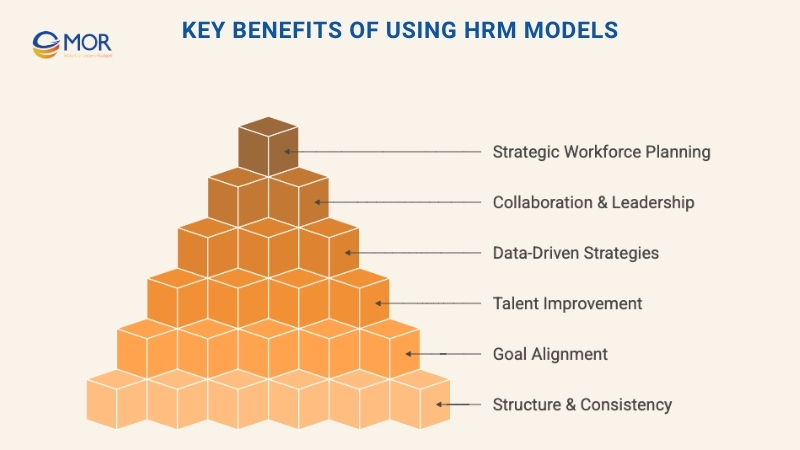
- Enable data-driven strategies and performance tracking: Many frameworks include built-in KPIs or metrics. That makes it easier to track results, adjust programs, and prove HR’s impact. Among large enterprise search, 34% plan to expand headcount in HR analytics, showing demand for metrics‑ready frameworks.
- Strengthen collaboration between HR and leadership: Models clarify roles and expectations, which helps HR speak the same language as execs and drive joint initiatives forward. Ikea cut US voluntary turnover from one‑third to one‑quarter of its workforce in a single year by tightening manager‑HR collaboration and feedback loops.
- Support long-term workforce development and planning: Whether you’re scaling up, entering new markets, or managing turnover, structured HRM models give you a long view and a roadmap to follow.
In short, these models help HR move from reactive to proactive, building systems that don’t just support growth, but help lead it.
Top 10 HRM Models Every HR Professional Must Know in 2025
With so many HRM models available, it can be hard to know which ones actually make a difference. We’ve gathered 10 of the most relevant and practical models that every HR leader should understand going into 2025.
HR Value Chain Framework
The HR Value Chain shows how smart people management links directly to business success. It connects daily HR work to the bigger picture, helping teams prove their value beyond just operations.
Developed by Jaap Paauwe and Richard Richardson, this model breaks HR down into five linked layers:
- HR Strategy: Sets the direction. This covers your goals for managing talent and shaping workplace culture.
- HR Services: Day-to-day processes like payslip, time tracking, and benefits.
- HR Resources: The people, tools, budget, and systems that keep things running.
- HR Management: Covers all the work around hiring, onboarding, development, and performance.
- HR Results: The measurable proof, KPIs, dashboards, and reports that show how your work supports business growth.
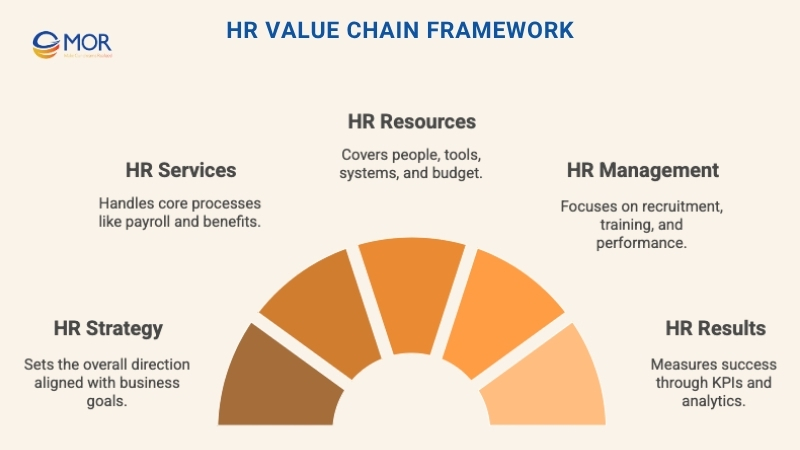
The real point? This model reminds us that HR isn’t just about process, it’s about outcomes. You’re not just building systems. You’re building value.
And if you’re planning system architecture or tooling, the uml diagram for HRM application layers model services repositories controllers could support this model well, especially for software teams mapping workflows from strategy to execution.
Advanced Strategic HRM Chain
This upgraded version of the HR Value Chain, built by Jon Ingham, takes things a step further. Instead of just aligning HR with business strategy, it zooms in on how talent drives real results. It’s a practical, people-first model designed for today’s fast-moving organizations.
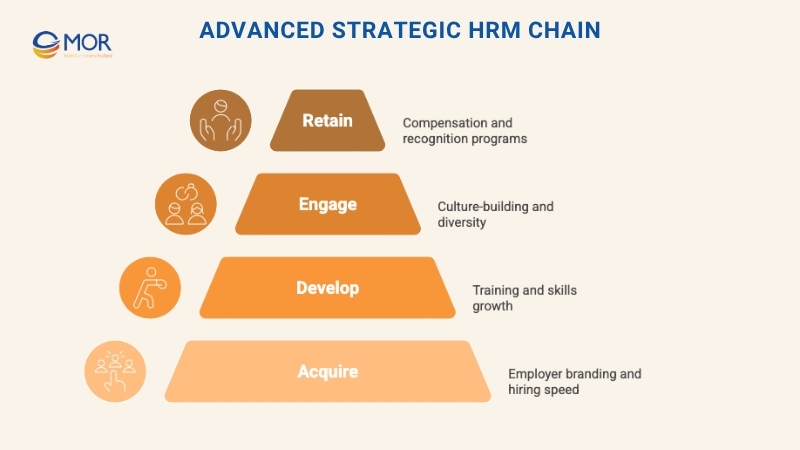
The advanced strategic HRM Chain has four key stages:
Acquire
Bring in the right talent, faster. This stage covers everything from building a strong employer brand to managing your hiring pipeline.
- Key metrics: eNPS, cost per hire, time-to-hire, selection ratio
Develop
Once hired, your people need to grow. Focus here is on training, coaching, and career development.
- Key metrics: training completion rate, ROI, coaching impact score, mentee satisfaction
Engage
You can’t just train talent, you need to keep them energized. This stage tackles culture, inclusion, surveys, and analytics.
- Key metrics: engagement score, diversity index, survey response rates, turnover rate
Retain
Great people will leave if they don’t see a future. Here’s where rewards, compensation, and career pathing come in.
- Key metrics: pay competitiveness, promotion rate, recognition program participation
What sets this model apart is how tightly it ties each HR activity to measurable outcomes. It’s a smart way to build a resourcing model that adapts to change, supports hybrid teams, and puts people at the center of business growth.
If your team is mapping this into tech platforms, consider breaking it into modules with clear ownership. This also sets you up to integrate performance tracking with your HRM models dashboard.
>>> READ MORE: Top 10 HRM Management Softwares For Business To Know In 2025
Harvard-Based HRM Model
First introduced by Michael Beer and the Harvard team in 1984, the Harvard model of HRM is one of the most widely taught and referenced HRM models today. It takes a big-picture view, showing how HR decisions must balance the interests of multiple stakeholders, not just the company.
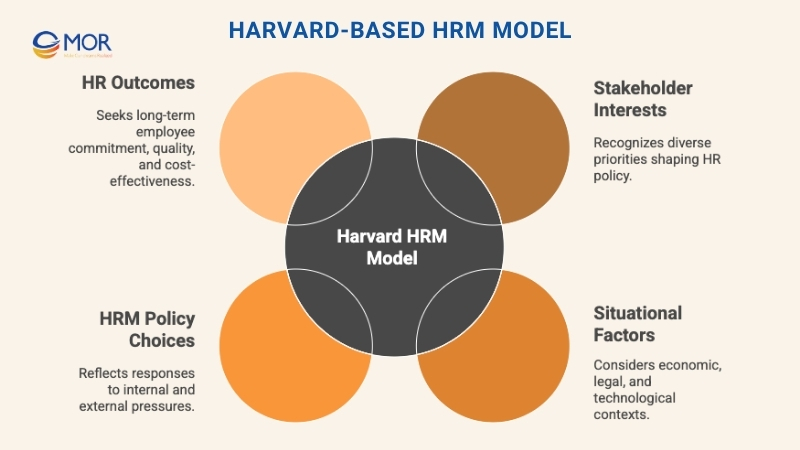
This model is built around four key parts:
Stakeholder Interests
HR doesn’t operate in a vacuum. It must balance what matters to shareholders, managers, employees, unions, regulators, and even local communities.
Situational Factors
What’s happening inside and outside the business shapes HR choices. Economic trends, hiring laws, tech disruption, and cultural shifts all play a role.
HRM Policy Choices
From communication to hiring, training, and compensation, this model reminds us that every HR policy is a response to both external pressure and internal priorities.
HR Outcomes
When things are well-aligned, the business gains committed, capable people, and HR runs efficiently.
This model is especially helpful when building or evaluating an HR framework. It forces HR leaders to think beyond short-term fixes and focus on sustainable alignment between people strategy and business goals.
Warwick HRM Planning Model
Built by Chris Hendry and Andrew Pettigrew at the University of Warwick, this model shows how HRM models link theory with practice. It focuses on aligning HR strategy with business goals, while accounting for the external and internal conditions shaping those goals.
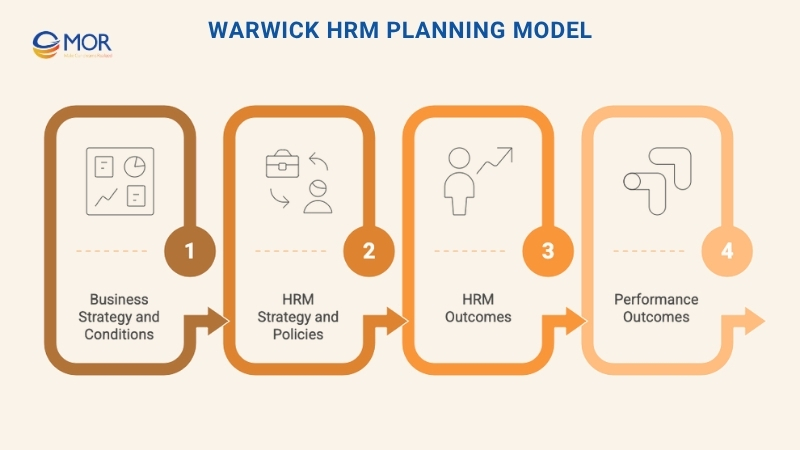
It’s broken into four key parts:
Business Strategy and Conditions
This includes the organization’s goals and the forces shaping them, things like leadership vision, culture, market shifts, legal rules, or tech trends. It sets the direction for HR planning.
HRM Strategy and Policies
Once business goals are clear, HR designs policies around hiring, training, compensation, and performance. The idea is to build people systems that support those goals.
HRM Outcomes
Well-built payroll management systems lead to outcomes like higher skill levels, stronger company culture, and more engaged teams. These outcomes shift employee behavior in the right direction.
Performance Outcomes
Eventually, the gains show up in metrics that matter to the business: productivity, quality, flexibility, and long-term competitiveness.
This model gives HR a clear role in building strategy from the inside out. It’s also a strong foundation for long-term planning, especially when defining the layers in your uml diagram for HRM application layers model services repositories controllers or building a data-driven planning tool for HR operations.
Ulrich’s Role-Based HRM Model
Dave Ulrich’s model, launched in 1996, reshaped how we think about HR. Instead of being buried in admin tasks, HR was repositioned as a strategic function. His ulrich HRM model outlines four distinct roles HR must play to support modern business.
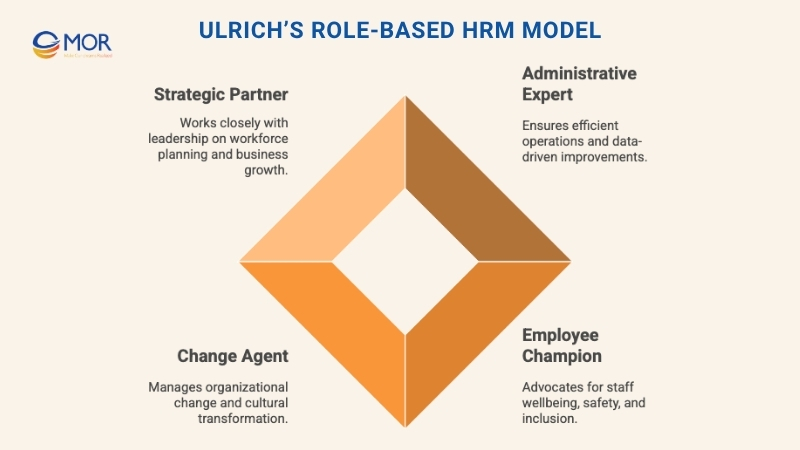
Administrative Expert
This is about getting the basics right, payroll, compliance, records, and benefits. But it’s not just paperwork. The expert role uses data to fine-tune operations and cut waste, making HR services faster and more reliable.
Employee Champion
HR should advocate for people, not just policy. This role focuses on employee well-being, listening to concerns, and building programs for engagement, inclusion, and safety.
Change Agent
This role steps in during transitions. Whether it’s rolling out new systems, shifting culture, or restructuring teams, the change agent helps diagnose pain points, manage communication, and guide the shift.
Strategic Partner
HR doesn’t just support business strategy, it shapes it. This role works alongside leadership to forecast workforce needs, develop talent plans, and link people investments to business growth.
The model helps HR balance day-to-day delivery with long-term thinking. It’s a smart reference for anyone modernizing their HRM models to reflect the broader impact HR should have in the boardroom. If you’re shaping HR in 2025, this role-based approach is hard to skip.
5P Strategic HRM Framework
Developed by Randall Schuler, the 5ps model of HRM offers a structured way to align HR strategy with business performance. It’s not just about tasks, it’s about building a system where everything from vision to action supports your people and goals.
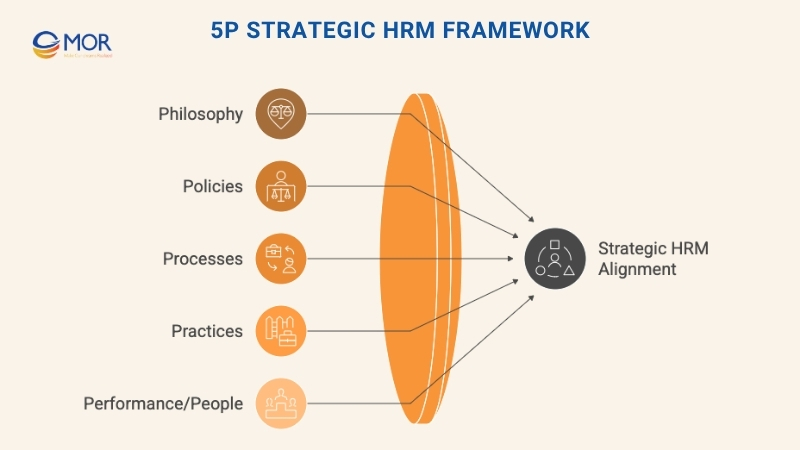
Here’s how the five layers break down:
Philosophy
This is your foundation. It includes your values, culture, ethics, and beliefs about how people should be managed. It shapes every other layer of your HR strategy.
Policies
These are the formal rules that guide decisions, compensation, conduct, remote work, compliance, and more. Clear policies help ensure fairness and consistency.
Processes
These are your actual workflows: how you hire, train, evaluate, and develop employees. Good processes improve outcomes and the employee experience.
Practices
These reflect how policies are applied on the ground. If policies say one thing but daily actions say another, there’s a disconnect. This model encourages closing that gap.
Performance/People
This is about tracking results. You’re looking at retention, productivity, engagement, and other metrics to prove that HR isn’t just busy, it’s effective.
The 5ps model of HRM supports a long-term approach to building a smart, resilient workforce. It also gives you a clear checklist when evaluating or refreshing your HRM models, especially when moving toward performance-based planning tied to real business targets. It’s a model that makes HR strategic from the inside out.
3G HR Responsibility Model
The 3G model breaks HR into three core responsibilities that every team needs to juggle. It’s a simple but sharp way to balance strategic goals with day-to-day support.
- Growth: This is about moving the business forward. It covers long-term planning, upskilling, and shaping future talent through things like succession planning and capability development.
- Guardianship: This role keeps the business safe, think compliance, blockchain platforms, legal rules, and ethical standards. It’s the quiet force that prevents costly missteps.
- Guidance: This is the human side. It’s how HR helps employees understand expectations, navigate policies, and make better decisions at work.
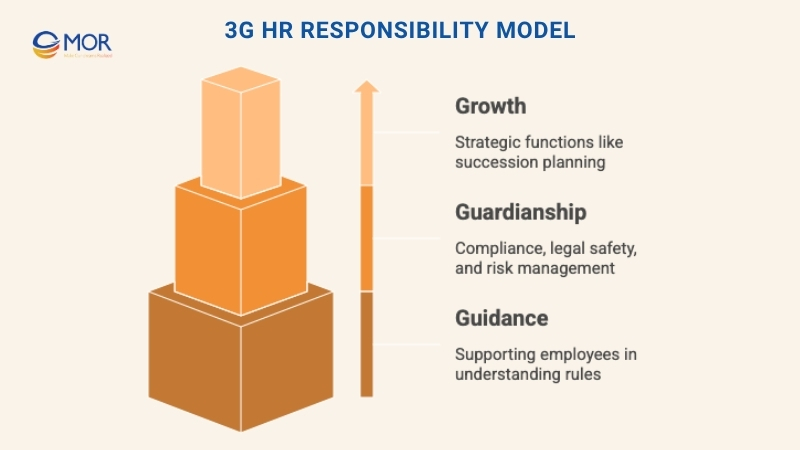
The 3G HR Responsibility Model gives you a lens to assess how your HRM models support all three areas. If your team leans too hard into one and neglects the others, you’re out of balance. For teams reviewing structure, it’s a handy checkpoint when updating their HR management models to stay relevant and well-rounded.
High-Performance HR Operating Model
This model shifts focus from just 'doing HR' to delivering real value. It structures the function around four core elements designed to raise the bar on performance and service.
- HR Customers: Everything starts with the people HR serves, employees, managers, and candidates. Their experience should be seamless and meaningful.
- Digital Workplace: Tools, platforms, and systems that automate tasks and support smarter decisions. Think of this as the engine room of modern HR.
- Workforce Insights: It’s not just about having data, but knowing what to do with it. This pillar focuses on analyzing trends, spotting risks, and guiding strategy.
- Fluid Operating Model: The old rigid org charts don’t work anymore. HR teams now need to flex, move fast, and stay connected across functions.
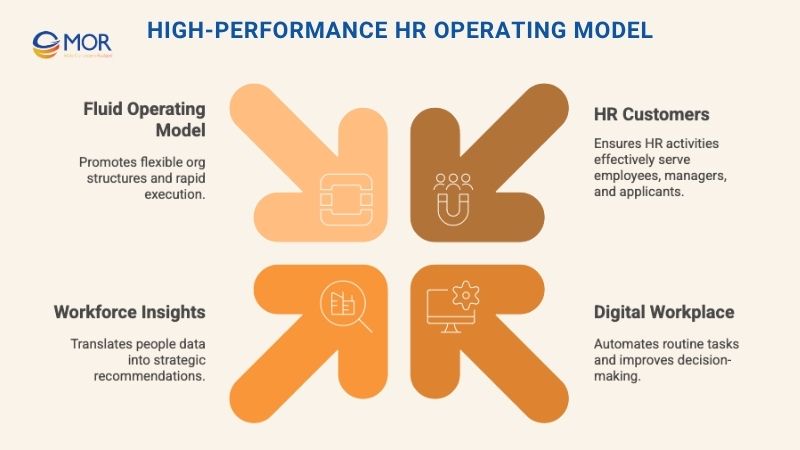
This model helps HR become a strategic player, not just a support role. When applied right, it gives structure to HRM models that scale and adapt quickly. It also pairs well with modern platforms that collect and act on the kind of data found in 10 examples of human resources metrics, retention, engagement, diversity, and more.
Employee Lifecycle Value Chain
The Employee Lifecycle Value Chain connects the dots between your talent practices and long-term business success. Instead of treating hiring, training, and retention as separate tasks, this model shows how they work together as one system.
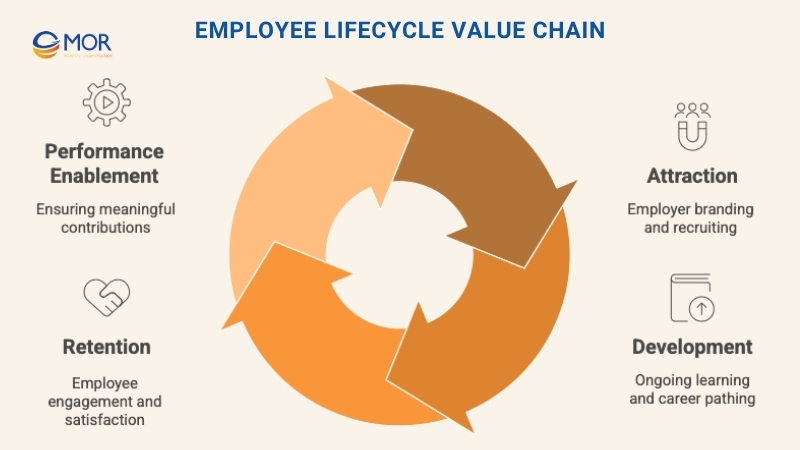
It runs on four pillars:
- Attraction: Build a strong employer brand and recruiting process to bring in the right people from the start.
- Development: Invest in upskilling and career growth to keep employees learning and evolving.
- Retention: Create a culture where people want to stay, with strong leadership, recognition, and meaningful work.
- Performance Enablement: When the first three pillars are working, teams deliver real results. This is where capability meets impact.
This framework is especially useful for aligning HRM models with business goals over time. It’s not just about short-term hiring fixes, it’s about building a talent system that lasts. For teams planning their approach to HR in 2025, this model supports long-view thinking grounded in execution.
4C HR Competency Model
The 4C HR Competency Model, created by Susan R. Meisinger, outlines the skills HR professionals need to truly lead, not just support, the business. It’s a practical model that helps build HR teams ready to drive transformation.
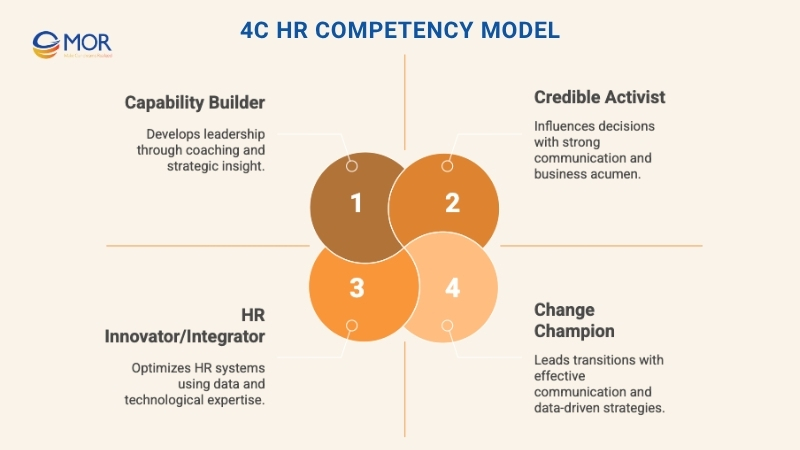
Here’s the breakdown:
Credible Activist
You need more than people skills. HR leaders should know the business inside out, strategy, operations, and finance. This role combines influence with insight, using data to guide leadership on people-related decisions.
Capability Builder
HR’s job isn’t to do it all, it’s to build strong leaders who can. This means coaching, training, and giving managers the tools to lead their teams with confidence.
Change Champion
This role is all about navigating and driving change. Whether it’s restructuring or rolling out new policies, HR leads the people side of transitions and keeps morale strong throughout.
HR Innovator/Integrator
Data, tech, and tools aren’t extras anymore, they’re essential. This role focuses on using digital systems and analytics to improve programs and tie them to business outcomes.
Together, these four Cs build HR teams that are proactive, skilled, and ready for what’s next. As more companies reevaluate their HRM models, especially in tech-driven environments, this model stands out for its focus on people-first leadership backed by smart tools. It’s also a strong fit for teams designing a modern HR framework with real business influence.
How To Choose The Right HRM Models For Your Business?
Not every company needs the same kind of HR setup. The best HRM models fit your team’s structure, business goals, and long-term direction. Here’s what to think about before you commit to one:
- Business strategy: Start here. If you're chasing measurable business outcomes, go with models like the HR Value Chain that connect HR to performance. If engagement and growth matter more, models like the 5ps model of HRM offer long-term support.
- Org structure: How your company is built matters. Bigger, layered teams might benefit from the ulrich HRM model with defined roles, while leaner orgs might prefer something like the Warwick model for its flexible planning approach.
- Industry needs: Fast-changing industries often demand agility and innovation, while others are compliance-heavy. The model you choose should reflect those priorities, whether that’s talent development or risk control.
- Team readiness: Your HR model is only as good as your team’s ability to use it. Strategic models need teams with analytical skills, tech fluency, and leadership buy-in. For teams still growing in capability, simpler frameworks might work better.
- Return on effort: Ask yourself, will this model deliver actual value? Look for models that link activity to measurable outcomes, helping you justify your HR investments.
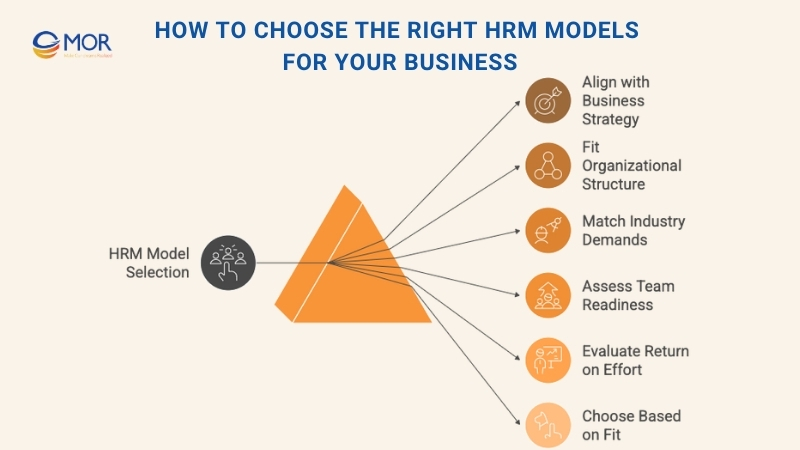
Choosing the right model doesn’t mean picking the most popular one. It means finding a fit that lets your HR team operate smarter and support business growth with confidence. Whether you're building a new resourcing model or reworking old systems, your model should guide decisions that move the needle.
Future Outlook for HRM Models
HRM models aren’t just theory, they shape how teams focus, make decisions, and measure success. They offer structure when things feel uncertain and direction when priorities shift.
As we head into 2025, the pace of change isn’t slowing down. That’s why it’s smart to understand what these models teach, then adjust them to fit what your business really needs.
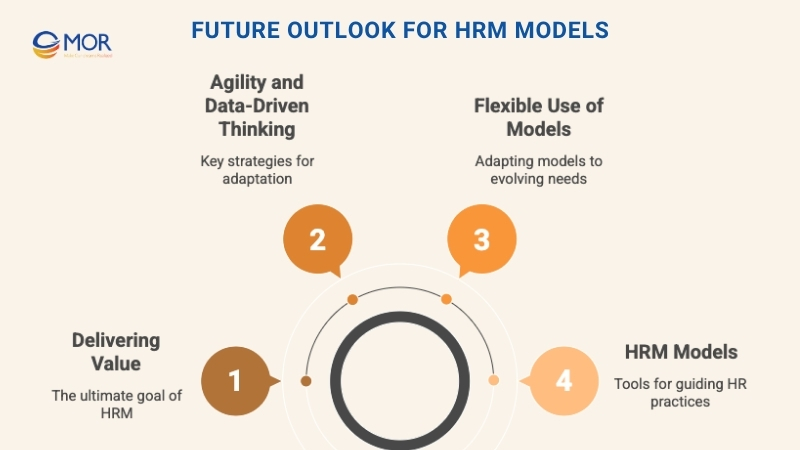
The best HR leaders don’t pick one model and stick to it forever. They mix, adapt, and evolve, always with one goal in mind: making HR more valuable for people and the business.
In a world where agility and data drive every decision, staying grounded in the right HRM models will keep your team focused, relevant, and ready for what’s next.
MOR Software Helps Businesses Bring HRM Models to Life
Most hr software for small companies don’t struggle to choose an HRM model. They struggle to apply one. That’s where MOR Software steps in.
We build custom HRM systems that match the structure, flow, and logic of whichever model your team uses: Harvard, Ulrich, 5P, or something hybrid. Our developers work directly with your HR and leadership teams to turn concepts like “employee champion” or “performance enablement” into usable features and workflows.
We’ve built:
- Tools that map career paths and track internal promotion metrics
- Dashboards that show retention, engagement, and learning KPIs
- Role-based access for HR teams following the Ulrich Model
- Full-cycle automation from hiring to review, based on your process
Every HRM model depends on consistency, data, and execution. Our job is to help you build the system that supports all three. Whether you're managing a global workforce or scaling a startup team, we make sure your HR strategy doesn’t get lost in theory. With MOR, your model actually works because your system does too.
Conclusion
Strong HR starts with the right structure. The HRM models we’ve highlighted aren’t just theory. They’re practical tools for better decisions, smarter planning, and stronger teams. At MOR Software, we help businesses bring these models to life through custom software solutions that support everything from workforce analytics to recruitment systems. Need help choosing or implementing the right HRM model for your business? Contact us to get started.
MOR SOFTWARE
Frequently Asked Questions (FAQs)
What are HRM models?
HRM models outline how HR supports the business and where it fits in the bigger picture. They help define HR’s responsibilities, show how HR contributes to business success, and clarify how business goals can shape HR priorities.
Which HRM models are most widely used?
Some of the most widely used HRM models include the HR Value Chain, the Harvard HRM model, and Dave Ulrich’s role-based approach.
How are HRM models changing?
HRM models are shifting as the function takes on new responsibilities. Tech-driven service, agile team structures, and long-term workforce sustainability are now part of the conversation. Future models will likely reflect more flexibility, automation, and people-first thinking.
Rate this article
0
over 5.0 based on 0 reviews
Your rating on this news:
Name
*Email
*Write your comment
*Send your comment
1